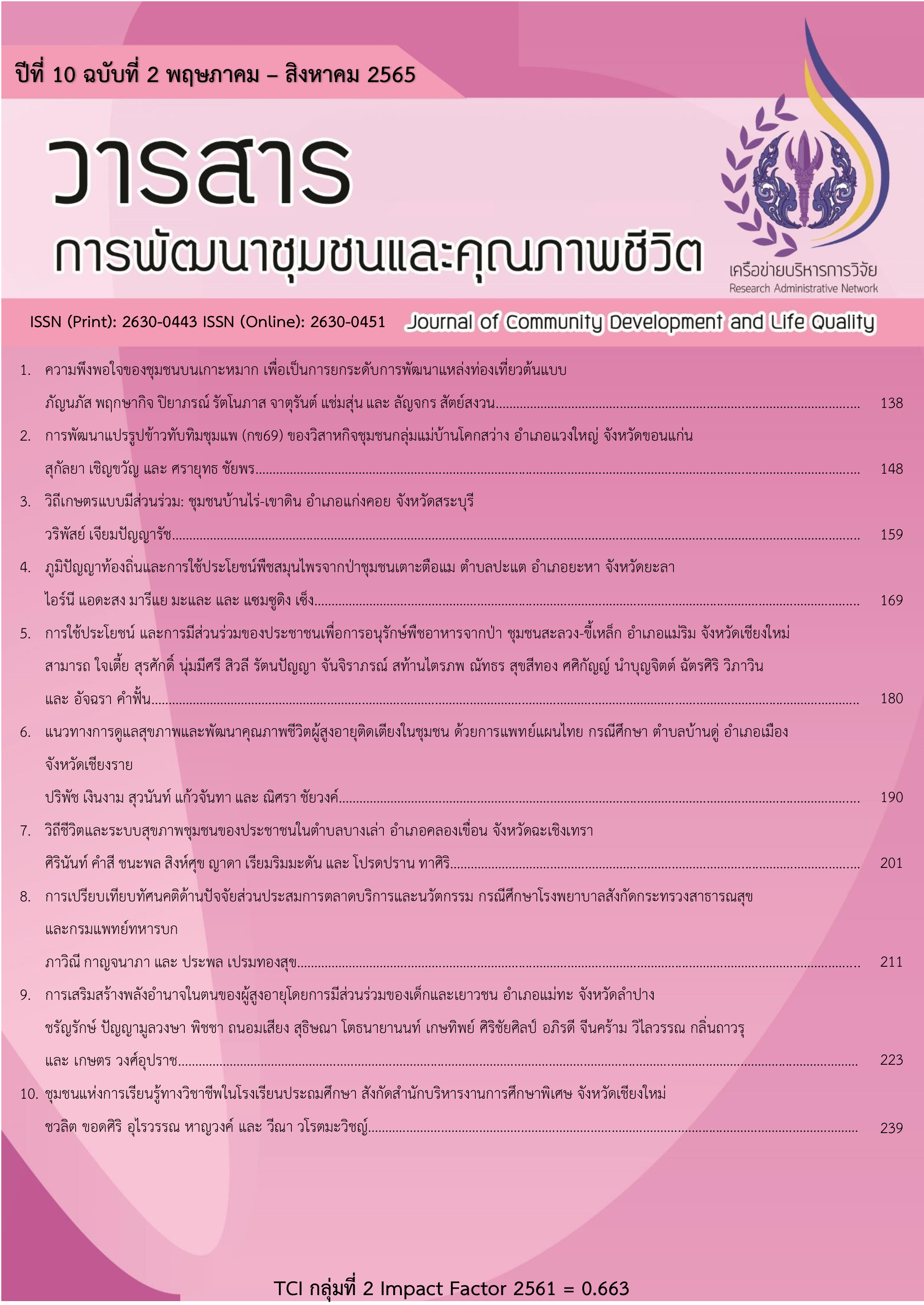Processing of Tubtim Chumphae Rice (RD69) of Ban Khok Sawang Housewives Group Community Enterprise, Wang Yai District, Khon Kaen Province
Main Article Content
Abstract
The objective of this study was to develop a product that transforms Tubtim Chumphae into a crispy rice cracker by using the participatory action research with the Ban Khok Sawang community enterprise. The participants were the group members of 20 people. Tubtim Chumphae were experimented to process crispy. The experiment shows that using ratio of glutinous rice 60% to 40% Tubtim Chumphae resulting in the uncooked rice pads had an increased reddish color and had a round disc shape, when the rice pad was fried, it shows that the rice hornet plates were rounded with red and white colors mixed throughout the sheet, which satisfied all participants. The study also assessed satisfaction on the crispy rice cracker of 50 customers in Mueang District, Khon Kaen province by using questionnaire. The result shows that the overall satisfaction was at a high level. Customers also have additional suggestions as the tasted should be improved to be more diverse as an alternative to consumers and the crispy rice crackers have a hard texture because Tubtim Chumphae rice does not swell which causes unevenness of the product.
Article Details

This work is licensed under a Creative Commons Attribution-NonCommercial-NoDerivatives 4.0 International License.
The Editorial Board claims a right to review and correct all articles submitted for publishing
References
Changsri, R., S. Bureerat, T. Prungkong, A. Pengrueng, A. Pongpanus. et al. 2016. RD69 (Tubtim Chumphae), a non glutinous rice variety. Thai Rice Research Journal 7(2): 30-46. (in Thai)
Charoenphun, N. 2020. Utilization of broken rice for rice cracker production. Thai Science and Technology Journal 28(12): 2150-2163. (in Thai)
Chumjit, S., W. Sangartit, U. Kukongviriyapan, P. Pakdeechote, V. Kukongviriyapan and S. Thawornchinsombat. 2017. Effects of Tubtim Chum Phae rice bran hydrolysates on blood pressure and oxidative stress in L-NAME-induced hypertensive rats. KKU Research Journal (Graduate Studi25) 17(3): 19-29.
Chutimanukul, P., C. Jeankham and S. Ngamluan. 2021. Effect of calcium silicate from cement industry on growth, yield and silicon accumulation of Riceberry and Tubtim Chumphae rice varieties. Khon Kaen Agriculture Journal 49(3): 577-585. (in Thai)
Community Enterprise Promotion Division. 2018. Outstanding community enterprise 2018. (Online). Arailable: http://www.sceb.doae.go.th/Documents/cebest61.pdf (access: 15 October 2020)
Khorphon, S., J. Pankeaw, T. Sarobol, S. Sitthisongkram, S. Chaisrisawat, S. Chaisrisawat and P. Norsak. 2014. Use of participatory action research (PAR) in preventing and solving problems caused by alcohol consumption in the community of Nong Toa Kammai Village, Pa Phai sub-district, San Sai district, Chiang Mai province. Journal of Community Development and Life Quality 2(3): 313-324. (in Thai)
Malasri, K. and J. Yawara. 2021. Self improvement in pandemic situations: A case study at Tub-Tim Chumphae Rice Agriculture Group, Chumphae district, Khon Kaen province. (Online). Available: http://www2.huso.tsu.ac.th
/ncom/csd/csdful_pdf/F150.pdf (January 20, 2021). (in Thai)
Phalasuek, R., B. Thanomchayathawatch and D. Songloed. 2018. Participatory action research: Development of a participatory process for health promotion in the community. The Southern College Network Journal of Nursing and Public Health 5(1): 211-223. (in Thai)
Phalasuek, R., B. Thanomchayathawatch and D. Thonglert. 2017. A community participation process in teenage pregnancy prevention. The Southern College Network Journal of Nursing and Public Health, 4(2): 256-267. (in Thai)
Phuphaibul, R., S. Watanasak, N. Jitramontree, M. Apanuntikul, A. Youngpradith, et al. 2012. Development process for sufficiency health in community. Journal of Nursing Science and Health 35(1): 28-38. (in Thai)
Ponglong, J., L. Senggunprai, P. Tungsutjarit, R. Changsri, T. Proongkhong, S. Thawornchinsombut and P. Pannangpetch. 2018. Hydrolysate and ethanolic extract of Tubtim-Chumphae rice bran improve insulin resistance in high fat-high fructose diet fed rats. Srinagarind Medical Journal 33(5) (Suppl.): 59.
Pupaka, D. 2016. Participatory action research for the development and technology transfer in science toward the standardization of community product: The case study of the community business group in Chachoengsao province. Area Based Development Research Journal 8(1): 116-145. (in Thai)
Putjorn, T., L. Veranavin, K. Kheovichai and T. Unaromlert. 2013. Participatory action research in community-based tourism management for sustainable community development at Salakkhok, Trat province. Journal of Liberal Arts, Prince of Songkla University, 5(2): 102-117. (in Thai)
Sriroth, K. and K. Piyachomkwan. 2007. Starch Technology. Kasetsart University Press, Bangkok. 303 p. (in Thai).
Trakoolchokumnuay, K. 2015. Innovation of rice porduction, rice processing, and rice trade in Thailand. Journal of Social Development 17(2): 51-67. (in Thai)
Vechgama, K. 2014. Development of crickets rearing group management with PAR at Ban Nong Lai, Kohka sub-district, Kohka district, Lampang province. Journal of Community Development and Life Quality 2(1): 89-96, (in Thai)
Wattanakul, U. and W. Wattanakul. 2019. Storage times of stale Tub Tim Chumphae paddy rices to proteins, fats content and bioactive compounds. Research report. Rajamangala University of Technology Srivijaya, Trang. 57 p. (in Thai)


